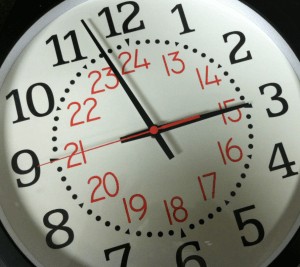 twenty four hour clock
twenty four hour clock
Understanding military time, also known as the 24-hour clock, might seem daunting at first glance. Terms like “zero two-hundred” (0200) or “twenty-three hundred” (2300) can sound more like codes than actual times. However, military time is a straightforward and logical system used across various sectors, not just the military. While the United States primarily uses the 12-hour clock with a.m. and p.m., grasping military time is not only useful but also surprisingly easy to learn.
Understanding the Basics of Military Time
Military time operates on a 24-hour cycle, eliminating the need for a.m. and p.m. designations. Instead of resetting at 12 twice a day, the hours continue from 00 to 23. This system provides clarity and avoids any ambiguity, which is crucial in fields like aviation, emergency services, and, of course, the military.
A key thing to remember is that military time is always represented with four digits. The first two digits indicate the hour, and the last two represent the minutes. Let’s break down some fundamental points:
- 0000 (pronounced “zero hundred” or “midnight”) marks the beginning of the day, equivalent to midnight in civilian time.
- 1200 (pronounced “twelve hundred” or “noon”) is midday, or noon in civilian time.
Times between 0001 and 1159 are generally considered “a.m.” in civilian time. For example:
- 0100 (pronounced “zero one hundred”) is 1:00 a.m.
- 0645 (pronounced “zero six forty-five”) is 6:45 a.m.
- 1130 (pronounced “eleven thirty”) is 11:30 a.m.
Times between 1201 and 2359 fall into the “p.m.” range in civilian time. This is where some initial confusion might arise, but it becomes simple with a quick trick. For instance:
- 1300 (pronounced “thirteen hundred”) is 1:00 p.m.
- 1800 (pronounced “eighteen hundred”) is 6:00 p.m.
- 2215 (pronounced “twenty-two fifteen”) is 10:15 p.m.
To further illustrate the conversion, here’s a helpful chart:
Military Time Conversion Chart
| 24-Hour Clock (Military Time) | 12-Hour Clock (Civilian Time) |
|---|---|
| 0000 | Midnight |
| 0100 | 1 a.m. |
| 0200 | 2 a.m. |
| 0300 | 3 a.m. |
| 0400 | 4 a.m. |
| 0500 | 5 a.m. |
| 0600 | 6 a.m. |
| 0700 | 7 a.m. |
| 0800 | 8 a.m. |
| 0900 | 9 a.m. |
| 1000 | 10 a.m. |
| 1100 | 11 a.m. |
| 1200 | Noon |
| 1300 | 1 p.m. |
| 1400 | 2 p.m. |
| 1500 | 3 p.m. |
| 1600 | 4 p.m. |
| 1700 | 5 p.m. |
| 1800 | 6 p.m. |
| 1900 | 7 p.m. |
| 2000 | 8 p.m. |
| 2100 | 9 p.m. |
| 2200 | 10 p.m. |
| 2300 | 11 p.m. |
Simple Tricks for Converting Military Time
The Subtraction Method for PM Hours
Converting military time from 1300 to 2359 to civilian time is straightforward using a simple subtraction trick. If you encounter a military time that is 1300 or greater, subtract 12 from the hour digits to get the civilian time equivalent in p.m.
For example:
- To convert 2100 to civilian time: 21 – 12 = 9. So, 2100 is 9:00 p.m.
- To convert 1630 to civilian time: 16 – 12 = 4. So, 1630 is 4:30 p.m.
The Addition Method for Converting to Military Time (PM Hours)
Conversely, to convert civilian p.m. times to military time, you can use addition. If you want to convert a p.m. time to military time, add 12 to the hour.
For example:
- To convert 7:00 p.m. to military time: 7 + 12 = 19. So, 7:00 p.m. is 1900.
- To convert 2:45 p.m. to military time: 2 + 12 = 14. So, 2:45 p.m. is 1445.
For a.m. times (except for midnight), the military time is essentially the same as civilian time, just expressed in four digits. For example, 8:00 a.m. is simply 0800 in military time. Midnight (12:00 a.m.) is 0000, and noon (12:00 p.m.) is 1200.
Practice Makes Perfect
Like any new skill, learning military time becomes easier with practice. Start by trying to convert times you encounter daily, whether on your digital devices or in schedules. You can also practice by using online military time converters or creating your own conversion exercises.
Understanding military time is not just about memorizing a chart or tricks; it’s about grasping a logical system that promotes clarity and efficiency in timekeeping. With these simple methods, you’re well on your way to mastering military time and understanding a system used worldwide for its precision and simplicity.
